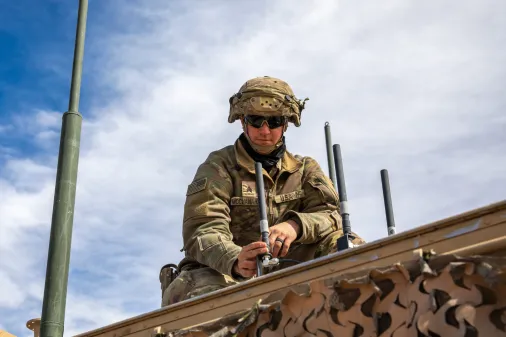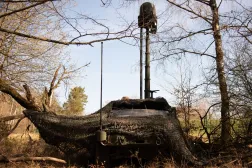New Army white paper lays out vision for high-tech force in 2030

The Army released a new white paper this week highlighting key technologies and other priorities for making the service a more “data-centric” force by the end of this decade, capable of defeating advanced adversaries on future battlefields with better-equipped, better-trained, and better-organized soldiers.
“The Army of 2030 must equip its forces with new and different capabilities,” it states.
The document, titled “Army of 2030,” says the service must acquire sensors to “see more, farther and more persistently” than its enemies; concentrate “low signature,” or less detectable, combat forces rapidly from dispersed locations; deliver high-precision, long-range fires; defend against drone attacks and other aerial threats; be secure from cyber and electronic attacks; and ensure it can “sustain the fight” over time across contested terrain.
New and emerging technologies on Army leadership’s wish list include a network of unmanned and manned sensors; robotic combat vehicles; hypersonic missiles; and directed energy weapons such as high-energy lasers and microwaves for mobile air defense.
Efforts to develop these systems are already underway as cross-functional teams at Futures Command and the Office of the Assistant Secretary of the Army for Acquisition, Logistics and Technology (ASAALT) pursue what Army officials describe as a “once-in-a-generation” transformation push, with long-range fires, next-generation combat vehicles, future vertical lift, the network, air-and-missile defense, and “soldier lethality” as the top modernization priorities.
The white paper also touts the Army’s efforts to facilitate Joint All-Domain Command and Control (JADC2), namely through Project Convergence, to better connect the U.S. military’s networks, sensors and shooters.
“We are innovating, through experiments like Project Convergence, to transform the Army into a data-centric force where commanders at all levels have the information they need to make decisions,” it states.
To facilitate JADC2 and better position itself to fight large-scale conventional wars, the Army is shifting its emphasis from brigade-level formations to larger formations that are better designed to work with the other services as well as allies and partners.
“Theater armies, corps and divisions will gain the personnel, organizations and equipment they need to disrupt, and defeat an adversary’s ability to achieve their objectives. These organizational investments are multiplied by leveraging advances in commercial data analytics to improve speed and accuracy of leader decision-making,” the white paper says.
Brigade commanders will need to concentrate on winning close-in fights, while division and corps commanders keep eyes on the bigger picture across areas of operation. The Army wants the ability to “converge effects” in the land, air, sea, space and cyberspace domains.
“Our study and analysis of recent conflicts, exercises, simulations and training indicate that brigade commanders must fully focus on winning the close fight. To allow front-line leaders to concentrate on the close fight, division and corps commanders will have the responsibility and capability to visualize the larger picture. Divisions and corps must be able to employ and allocate the growing array of lethal and non-lethal weapons to attack an enemy across all domains,” the white paper notes.
The document’s emphasis on technology extends beyond battlefield use cases and includes personnel management and training.
The Army is trying to build a “21st century, data-driven personnel management system” to improve how the service identifies, develops and manages talent, according to the white paper. The goal is to move away from an “industrial age” system of assigning people to jobs based on a narrow set of factors, and instead take a more holistic view of individuals to better match them with positions for which they would be well suited.
To improve readiness, the “Army of 2030 will harness advances in virtual reality and simulation technologies to train in more realistic environments at lower cost and with reduced risk to our forces,” it adds. “With the investments we are making, the Army will train Soldiers in simulated environments, where they can interact with and prevail against limitless threats and scenarios, enhancing preparedness from the smallest unit to the largest formation.”
Notably, the document emphasizes the need for the Army to acknowledge “fiscal realities” and stay on a “sustainable strategic path” — a balancing act that the service faces as it seeks to modernize for future fights while maintaining current readiness.
The white paper suggests that efforts to bring new capabilities online could be slowed down by funding shortfalls, noting that the pace of transformation will be “informed” by the amount of resources available between now and 2030.
“We must modernize sustainably,” the document says. “This will require hard choices about the pace of modernization and the risk we assume in order to chart a long-term course to integrate new capabilities while maintaining our ability to respond to crises.”
Service leaders’ vision for the “Army of 2030” is expected to be a major topic of discussion at the Association of the United States Army’s annual convention next week in Washington.






